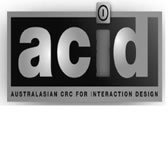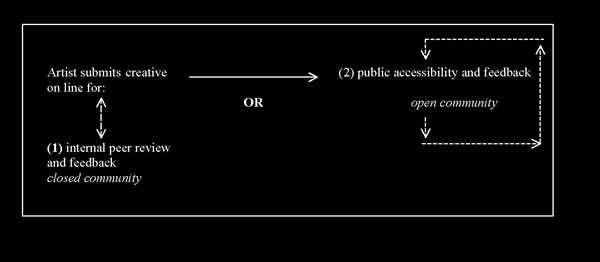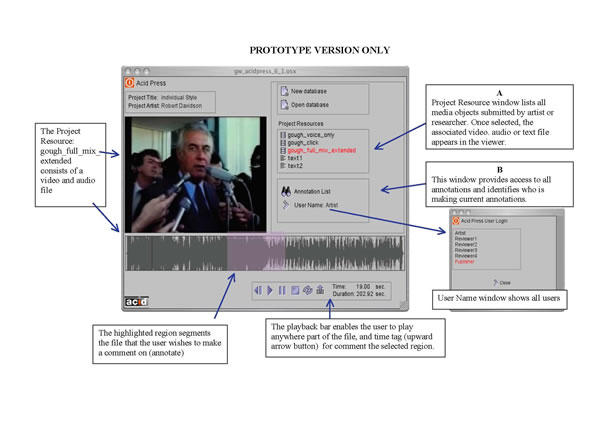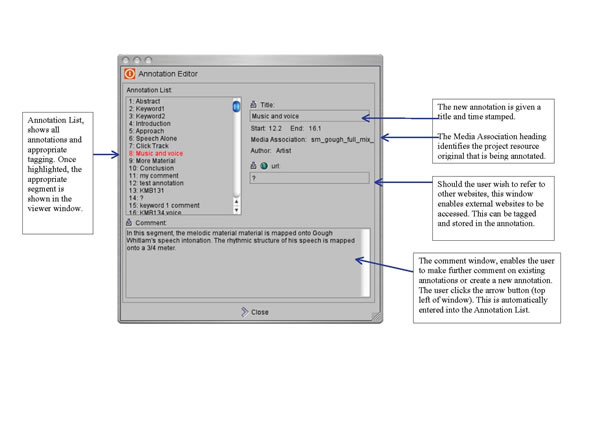31 July 2007
ACID Press: a New Approach to Knowledge Collaboration

E-Prints repositories and non text-based media
The Internet and associated software resources present many opportunities to those creative artists working within the university system whose research careers are dependent on the Research Quality Framework (RQF)1. as implemented by the Department of Education Science and Training (DEST).
The RQF framework consists of two points of reference: quality and impact. Quality is defined by the peer review process. Impact is associated with the transfer of knowledge across disciplines and boundaries. Quality is measured by the reputation of the peer review publication. Impact is currently measured by international, national or local effectiveness. This could be international distribution, a national radio or magazine interview, commercialisation, or a community project2.
To achieve maximum impact, a publication or work of art must be accessible to various communities: the more accessible, the more the research impact. To maximise impact, universities have adopted an e-print archive strategy. E-prints is a digital repository for peer reviewed and other research papers. While e-print repositories enable researchers to access and deposit research online, they are text-based and do not currently deal with mixed media. This presents a problem for creative arts researchers working in non text-based media. How does one report the research findings and experiences of creative works that involve sound and image in an alternative format?
Data capturing processes have previously favoured written text presentations. For example, in many grant submission environments such as Discovery or Linkage grants of the Australian Research Council (ARC), research applications are submitted online as text. Reference can be made to music or creative work, however the submission process does not enable media based on time (sound and video) to be included within the same mode of presentation. Hence relationships between sound, text and image cannot be experienced and present a problem for creators such as composers, filmmakers, video artists and installation artists.
The new generation of web resources combines social networking with knowledge dissemination. These challenge the previously preferred book-modelled approach to publishing. Sites like YouTube (www.youtube.com) and MySpace (www.myspace.com) integrate blogging, video and audio streaming. Their approach to collaborative knowledge sharing has redefined the relationship between author, editor, publisher and community.
These collaborative knowledge sharing environments (commonly called Web 2.0) raise many exciting issues regarding authority, commercial influence and knowledge relationships. While this is not the space to discuss Web 2.0 issues in any detail, collaborative knowledge sharing is clearly having an impact on the more traditional approaches to publishing and control of dissemination: the Napster court case for illegal downloading in 2000 is one such early example.
Accessibility and speed on the Internet are paramount. Knowledge becomes digitised into objects which become freely available and can be re-purposed for one’s own needs. At any point in time, someone can upload a file for a specific context. Automatically, this file, now a published digital object, can be viewed, commented on and redistributed by anyone having access to that object. This raises questions regarding expertise and elitism since no site is impervious to bias or wrong information. A community’s arbitration of knowledge may not necessarily be correct as can be seen on some wiki sites. Some people ask: where is the authority and accountability in a wiki site? The counterargument to this is that the community will, in time, self correct any anomalies or inconsistencies. Because of a community’s access to and dissemination of knowledge objects, collaborative knowledge sharing – as exemplified by Web 2.0 – challenges the nature of knowledge itself, the nature of authority and a community’s relationship – be it legally, ethically or morally, to itself and other communities.
Parallel to the emergence of Web 2.0 knowledge sharing environments has been the development of more sophisticated digital asset management systems (DAM)3 and content management systems (CMS)4. As communities engage with knowledge objects, the storage of and access to knowledge becomes important. Access to information must be fast and not cumbersome. CMS, with their ability to store, retrieve and catalogue data according to any defined criteria, are ideal for online publishing allowing for annotation (the ability to comment and tag), commentaries and dissemination. In many DAM and CMS, annotation is primarily text-based. There are excellent examples of text-based annotation for peer reviewing, however, there is less support for the use and integration of time-based rich media annotations in the peer reviewing process5. This presents a problem for the documentation of a creative work that is time-based or performance-based.
ACID Press: a solution
ACID Press – an annotation and publishing environment for interactive multimedia6 – offers solutions to many of the above-mentioned issues. Funded by ACID (Australasian CRC for Interaction Design) (www.acid.net.au ), it is currently in a developmental phase.
While impacting on myriad levels, ACID Press primarily provides insights into the understanding of knowledge relationships and transfer. It is relevant to the presentation and publication of creative artists’ work in which the experience of the work is an important part of the research argument. ACID Press is able to provide commentaries on audio, video, text and image files within the same environment. It is not a content management system but is designed to be integrated with existing content management systems. This means that the creative work, once uploaded into a content management system, can be annotated, peer reviewed, tracked and disseminated, depending on the user’s or community’s specific needs. ACID Press supports annotations of collections of time-based media in the documentation of a creative work. Furthermore, annotations can be made via other time-based media not just text.
ACID Press has the clarity and simplicity of a wiki7 model combined with the possibilities offered by annotating time-based media. It can present creative work in a curatorial format or as research with annotations for review and feedback. The wiki capability will enable communities (be they open or closed) to access the creative work and all the commentaries associated with that creative work. Its accessibility and transferability can help determine a creative work’s research impact and relationship to knowledge transfer (see diagram).

How ACID Press works
In the following example, we have chosen to use Robert Davidson’s audiovisual work Well may we say… from Big Decisions (2001). The screen shots presented here are from the prototype version only and were built in the Director environment. The first version for public release is currently being built in the Flash environment. As it was built to show potential, the prototype has limited functionality. The Flash version will have more utilities and sophisticated functionality.
Each window in the ACID Press environment enables some commentary or provides access to rich media resources. In the prototype version, the opening window displays the various resources the artists or researcher has submitted (Project Resources, See A), and a window (see B) providing access to all the annotations (annotation list) and who has made a comment (user name).

Once the user clicks on the Annotation List (see Binoculars button in Window B above), all annotations are shown. This becomes the Annotation Editor. The user simply highlights any of the annotations and that segment will be presented in the viewer window. These annotations enable the researcher to present a case, discuss aspects of the creative work, or compare one segment with another.

One issue we are currently addressing is metadata. Metadata is data about data. It is a standard used in digital environments to catalogue such things as ownership, authors, attribution rights and file types. This is important for the searching of information on the Web and databases as well identifying copyright and intellectual property. While there have been many standards for text publications, there is little conformity for rich media outcomes. ACID Press is developing a viable metadata standard so that all significant features concerning the digital object are appropriately catalogued. This will have impact on knowledge management such as attribution and knowledge transfer.
Summary
ACID Press as a rich media publishing environment provides single-platform access to creative work as research. It can be linked to existing content management systems so that creative works can be accessed, peer reviewed and tracked in ways that meet the specific needs of the user or community of practice. ACID Press enables social networks and communities of practice to access the work itself and all the commentaries associated with it.
By submitting a creative work through ACID Press, artists can:
- present their work in a research context;
- include the experience and annotation of the work in the research argument;
- receive peer-reviewed evaluation in the presence of the creative work; and
- disseminate findings to specific communities.
Conclusion
As university researchers are currently required to show evidence of their creative work regarding quality and impact, ACID Press provides the appropriate environment for the evaluation of a creative work’s relationship to peers and external communities. The creative work, in being the site for commentary, becomes ‘visible’ in the assessment of that creative work’s quality and impact. Furthermore, we believe ACID Press offers multimedia publishers a platform that complements contemporary publishing Internet environments. Within one location all aspects of the publishing and peer review process of rich media can be addressed: from original concept, proposal and production to dissemination and community feedback. Its annotation tools enable communication between publisher, editor, author/creator/composer/video maker etc., and audience.
People involved with ACID Press
Project leader: Richard Vella (Adjunct Professor, QUT)
Developer and Consultant: Jon Drummond (Squelch Multimedia, Sydney)
Peer advisors: Dr Barbara Adkins (QUT), Dr Axel Bruns (QUT), Dr Robert Davidson (QUT), Dr Steve Dillon (QUT), Dr Liz Ferrier (UQ), Paul Holland(ACID) and Dr Peta Mitchell
Flash developer: Natacha Beaugeais
Notes
The RQF has broadened to include a portfolio approach to research gathering. This enables the creative artist to include various creative works.
2. At the time of writing this article, the RQF is being discussed by academics around the country in relation to the measuring and evaluation of impact. This represents an exciting time for creative artists employed within the university system and whose work is not book-based or whose outcomes rely on temporal or spatial representations.
3. Digital Asset Management: ‘The process of storing, retrieving and distributing digital assets (files), such as logos, photos, marketing collateral, documents, and multimedia files in a centralized and systematically organized system, allowing for the quick and efficient storage, retrieval, and reuse of the digital files that are essential to all businesses’. [Accessed 20/3/07], http://www.bitpipe.com/tlist/Digital-Asset-Management.html
4. ‘A content management system (CMS) is a system used to manage the content of a Web site. Typically, a CMS consists of two elements: the content management application (CMA) and the content delivery application (CDA). The CMA element allows the content manager or author, who may not know Hypertext Markup Language (HTML), to manage the creation, modification, and removal of content from a Web site without needing the expertise of a Webmaster. The CDA element uses and compiles that information to update the Web site. The features of a CMS system vary, but most include Web-based publishing, format management, revision control, and indexing, search, and retrieval.’ [Accessed 20/3/07], http://www.bitpipe.com/tlist/Content-Management-Systems.html
5. Some interesting sites using annotation of multimedia are:
- http://www.annodex.net/
- http://www.mpi.nl/tools/elan.html
- http://matrix.msu.edu/
- http://www.plasticbag.org/archives/2005/10/on_the_bbc_annotatable_audio_project.shtml
- http://www.at.northwestern.edu/spoken/p04annotation.html
- http://www.spokenword.ac.uk/annotation.php
6. The term ‘rich media’ is also used to describe interactive multimedia.
7. ‘ Wiki is a piece of server software that allows users to freely create and edit Web page content using any Web browser. Wiki supports hyperlinks and has a simple text syntax for creating new pages and crosslinks between internal pages on the fly. Wiki is unusual among group communication mechanisms in that it allows the organization of contributions to be edited in addition to the content itself.’ [Accessed 28/01/07], http://www.wiki.org/wiki.cgi?WhatIsWiki
© Australian Music Centre (2007) — Permission must be obtained from the AMC if you wish to reproduce this article either online or in print.
Sydney-based composer and programmer Jon Drummond currently directs the digital media consultancy company, Squelch Multimedia (www.squelch.com.au).
Comments
Be the first to share add your thoughts and opinions in response to this article.
You must login to post a comment.